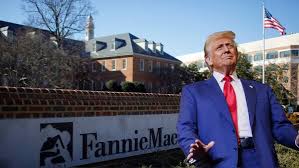Fannie Mae: The Secret Engine Powering America’s Housing Market You Never Knew About
“Fannie”
Fannie Mae: The Secret Engine Powering America’s Housing Market You Never Knew About
When people hear the name Fannie Mae, many think it’s just another government agency. But behind that familiar name lies one of the most powerful institutions shaping the U.S. housing market, mortgage rates, and the American dream of homeownership. Whether you’re planning to buy a home, invest in real estate, or simply understand how the U.S. economy works, knowing what Fannie really does could change how you look at money forever.

What Exactly Is Fannie Mae?
Fannie Mae, short for the Federal National Mortgage Association (FNMA), is a U.S. government-sponsored enterprise (GSE) founded in 1938 during the Great Depression. Its mission? To make homeownership more accessible and affordable for Americans.
Here’s how it works: Fannie Mae doesn’t lend money directly to homebuyers. Instead, it buys mortgages from lenders (like banks and credit unions), freeing up cash so they can issue more loans. This simple but brilliant system keeps the housing market liquid and stable.
Think of Fannie Mae as the backbone of America’s mortgage system—quietly working behind the scenes to make sure families can keep buying homes, even during economic uncertainty.
The Surprising History of Fannie Mae
The story of Fannie Mae begins in a time of economic despair. In the late 1930s, millions of Americans were losing their homes. The government created Fannie Mae to inject life into the housing market and make sure people could afford mortgages again.
Fast forward to today, and Fannie Mae has evolved into one of the largest financial institutions in the world, handling trillions of dollars in mortgage-backed securities (MBS). Despite facing challenges during the 2008 financial crisis, the company remains a vital part of the housing market’s recovery and growth.
How Fannie Mae Impacts You (Even If You Don’t Realize It)
You might never apply for a loan directly through Fannie Mae, but its influence touches your life in ways you can’t imagine.
Here’s how:
- Mortgage Rates: Fannie Mae’s market activity affects the rates you pay on home loans. When Fannie buys loans from banks, it helps lower interest rates for everyone.
- Home Values: A stable mortgage system keeps housing prices balanced and predictable.
- Economic Growth: By supporting homeownership, Fannie Mae fuels spending, construction, and job creation.
Even if you rent your home, Fannie Mae’s policies indirectly shape the housing affordability in your area.
Fannie Mae vs. Freddie Mac: What’s the Difference?
You’ve probably heard of Freddie Mac, another big name in housing finance. While both are GSEs, there’s a subtle difference:
- Fannie Mae primarily buys loans from large commercial banks.
- Freddie Mac works more with smaller banks and credit unions.
Together, they form the dynamic duo that keeps America’s mortgage market running smoothly.
How Fannie Mae Makes Money
Here’s where it gets interesting: Fannie Mae doesn’t just buy and hold loans. It bundles them into securities—called mortgage-backed securities (MBS)—and sells them to investors worldwide.
Investors earn steady income from homeowners’ monthly mortgage payments, while Fannie Mae earns fees for guaranteeing that those payments are made on time. This system provides security to global investors and stability to the U.S. housing economy.
It’s a win-win model that has quietly become one of the most profitable financial engines in the world.
The 2008 Financial Crisis: Fannie Mae’s Darkest Hour
In 2008, Fannie Mae faced its toughest challenge. As the U.S. housing bubble burst, mortgage defaults soared. Fannie Mae and Freddie Mac were hit with massive losses. To prevent total economic collapse, the U.S. government stepped in, placing both companies under federal conservatorship.
This intervention cost taxpayers hundreds of billions of dollars—but it also saved the housing market. Since then, Fannie Mae has rebounded stronger than ever, repaying the government and regaining investor trust.

Fannie Mae Today: Innovation Meets Stability
Today, Fannie Mae stands as a modernized powerhouse. The organization uses AI-driven underwriting, digital mortgage tools, and data analytics to make home loans faster, safer, and more transparent.
It also champions sustainability and affordable housing, funding green homes and supporting programs that help first-time buyers.
In 2025 and beyond, Fannie Mae is positioning itself as the digital heart of the housing industry—balancing innovation with its 80-year legacy of trust.
Is Fannie Mae Good or Bad for Homebuyers?
That’s the million-dollar question.
Pros:
- Keeps mortgage rates low
- Encourages banks to lend more
- Supports affordable housing
- Stabilizes the economy
Cons:
- Can encourage risk-taking in lending
- Heavy government oversight limits flexibility
- Criticized for being “too big to fail”
Despite its flaws, Fannie Mae remains the safety net that prevents the housing market from total collapse. Without it, getting a mortgage in America would be far harder—and far more expensive.
Fannie Mae’s Impact on Global Investors
Fannie Mae’s securities aren’t just popular in the U.S.—they’re a favorite among global investors looking for safe, long-term returns. These investments are considered almost as reliable as U.S. Treasury bonds.
By connecting global capital with American homeowners, Fannie Mae plays a unique role in bridging economies. Its financial network stretches from Wall Street to households across all 50 states—and beyond.
Final Thoughts: Why Fannie Mae Still Matters in 2025
In a world of rising inflation, fluctuating interest rates, and economic uncertainty, Fannie Mae remains the quiet hero of homeownership. It’s not flashy or trendy—but it’s the reason millions of families can live under their own roof.
Next time you hear the name “Fannie,” remember—it’s more than just a government acronym. It’s a symbol of stability, innovation, and the enduring dream of owning a home.
SEO Keywords & Tags (for Google ranking):
Fannie Mae, What is Fannie Mae, Fannie Mae mortgage, Fannie Mae vs Freddie Mac, Fannie Mae history, Fannie Mae 2025, housing market USA, home loan rates, real estate investment, mortgage-backed securities, U.S. economy.
